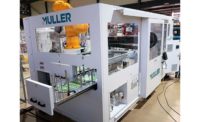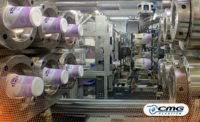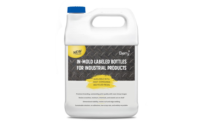Brand owners are always exploring new and exciting ways to ensure that their packaging stands out on shelf.
One of the fastest growing options for differentiation comes through in-mold labeling, especially for packaging of food products with a shorter lifespan, such as butter, margarine, ice cream, cottage cheese, yogurt and other dairy items.
This movement toward in-mold labeling has allowed brands to shift from common cylindrical packaging shapes to oblong, square and semi-square containers that stand out better on the shelf. This change also provides added benefits to brand owners looking for lighter weight packaging options.
Due to the extremely high temperatures created from the injection molding process, printers have to use films and inks that require superior heat resistance. Hot resins from the plastic could cause the wrong inks to wash away.
Historically, UV-cured inks have provided the needed results to resist the extreme heat of in-mold labeling and delivered the brand’s requirements of color accuracy, high gloss, abrasion resistance, durability for outdoor exposure, and low or no volatile organic compounds.
UV-cured inks do present some unique challenges for in-mold labeling. For example, UV lamps generate significant heat of approximately 1,600mW/cm2 and 74mJ/cm2. When improperly used or balanced, UV lamps can cause distortion or warping in the films and the inks. Lamps that are too hot can cause films to become brittle or curl – two factors that can create significant problems in an injection molding machine. Under-cured inks can cause ink washout or poor slip.
From an energy standpoint, UV lamps contain mercury bulbs, which is a concern for some printers due to the cost of disposal and environmental worries. Mercury lamps provide approximately 2,000 to 3,000 hours of usage and require a few minutes to warm up to reach curing temperatures of approximately 140 degrees Fahrenheit. The result is upwards of approximately 2,100 kilowatt hours per week of energy usage by a printer.
Another challenge printers face is the ozone created around the mercury lamps, which generally require the need for exhaust systems.
Exploring the Transition to UV LED Curing Lamps
Some converters looking for ways to improve efficiency and cut down on energy costs have explored the option of switching from mercury lamps to LED curing lamps. There are plenty of reasons to understand the desire to move toward LED. LED lamps are extraordinarily energy efficient, reaching a maximum of 104 degrees Fahrenheit instantaneously without any start-up delays.
LED lamps eliminate the need for exhaust, have a longer lifespan, do not contain heavy metals like mercury, and offer a more consistent UV output over their operating life. According to an energy efficiency study by Fogra, the organization concluded that LED curing showed energy reductions of up to 82 percent with a savings of approximately $18,000 per year.
Conventional UV-LED also have the added benefit of curing products faster, thanks to a greater curing efficiency and less distortion on the substrate. UV-LED allows products to move from the press to the fill stage faster.
All the same, making the decision to switch from UV mercury curing lamps to UV-LED curing lamps still has to jump some important hurdles. A printer needs to determine if a switch would justify the total cost. First there are the capital expenses required to replace the system. LED curing lamps certainly cost more per unit, but last much longer. At the same time, a UV mercury curing lamp system costs less and requires fewer bulbs to cure.
Additionally, there is the challenge of utilizing inks that work for in-mold labels. The task for ink manufacturers is to create an ink that cures with UV-LED lamps and has the ability to endure the injection molding heat.
Sun Chemical has developed a new UV-LED ink designed to meet these requirements. Formulated with a higher viscosity in order to cure with conventional UV-LED lamps and at faster curing speeds on difficult substrates, such as films used for in-mold labels, the new SunCure UV LED high performance range of UV-curable printing inks offer excellent adhesion to films and papers, provide good printability and lithographic performance, bring excellent color strength, have outstanding cure, and deliver with good gloss and scuff properties.
Meeting the Low Migration Regulatory Standards
Since brand owners have the responsibility to ensure safe packaging and compliance with all regulations worldwide, focus on food safety is at an all-time high. It is incumbent upon brand owners to scrutinize their supply chain from all angles to minimize risk.
This applies to packaging as much as to product sourcing and preparation. Where food or sensitive cosmetic products are concerned, it is vital that brand owners work hand-in-hand with their partner converters to ensure that the inks being used are suitable for the contents and pose no risk to consumers.
In-mold labels have to abide by these same strict regulatory standards, such as the Swiss Ordinance and REACH. It is important that the inks exhibit the qualities needed to meet those requirements.
Designed specifically for low migration packaging, Sun Chemical’s SunCure UV LED ink series has more polymeric ingredients which lend more toward compliance to the strict global low migration standards in the marketplace. Additionally, the inks offer low odor solutions that are undesirable on labels for food packaging applications.
Conclusion
While UV curing has traditionally met the heat resistance requirements for in-mold label packaging applications, UV-LED curing is now moving forward in the space with the potential promise of cost savings. With inks now available that meet both the strict requirements for in-mold labels and low migration standards in the marketplace, converters now have more options to consider as they weigh the justification of making the switch.
Sun Chemical







